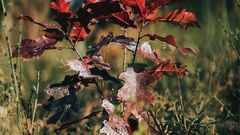





Introduced in Europe in 1724, it is often used as an alignment tree in cities because it resists pollution . Red oak owes its name to the reddish tint of its wood .
EcoTree plants red oaks because they have a great resistance to drought. In addition, red oaks maintain higher photosynthetic activity than other oaks.
American red oak prefers clay soils . Planting is done in autumn or spring. Its roots are deep and spread out. It likes light, well-drained and acidic or neutral soils but does not support limestone.
Red oak requires sunny or semi-shaded exposure . It is very rustic and tolerates winter temperatures of around -35 ° C and air pollution . It is also resistant to periods of drought, poor soils and powdery mildew. During the first two years after planting, the American red oak requires regular watering.
It is a wood that works well with few knots , a grain straighter than common oaks: excellent wood used by carpentry, cabinetmaking.
Its heartwood has good technological qualities . However, it is not very durable and is not suitable for making staves.
The red oak is often associated with absolute love. It is probably because of its vivid colour, its leaves that turn red in the autumn and its ever-shining appearance that the American red oak represents passionate and absolutelove. When we talk about red, a feeling comes immediately to mind: " passion". It is therefore the ideal gift for Valentine's Day and a love wish to your loved one. How about turning a bouquet of red roses into an original and lasting Valentine's Day gift?
Plant trees to say "I love you": because love takes root, grows and blossoms!